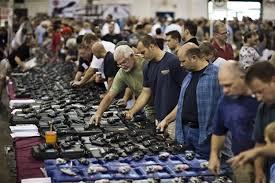Sometimes, when the government abuses its tremendous power to scapegoat someone, even proponents of government power find it to be too much.
Mike Weisser is a liberal who writes frequently for the Huffington Post in favor of gun control. Indeed, I have been the target of some of his attacks. But in a new book, “Sandy Hook: A Man Sold A Gun,” Weisser tells the story of a friend of his, Dave Laguercia, whose life was destroyed by the Obama administration in its quest to be seen as proactive in the aftermath of the Sandy Hook tragedy. Weisser describes Laguercia as an honest, law-abiding, decent man.
The emotions at the time were understandable. Adam Lanza had just massacred 27 people at Sandy Hook Elementary School in Newtown, Connecticut.
Laguercia’s “offense” was that he had legally sold firearms to the shooter’s mother, Nancy Lanza. He sold a Bush Master AR-15 style “assault rifle” in 2011 and a Sig 226 semi-automatic handgun in 2010. All the paperwork was properly filled out, and Nancy Lanza had passed the background check. Laguercia did nothing wrong.
Weisser sums it up nicely: “For selling a legal product to a consumer and selling it following exactly the rules and regulations which governed such sales, Dave lost his entire business and millions of dollars in sales, inventory and future profits, lost his reputation, spent thousands of dollars on legal fees and now sits at home still waiting for the legal aftermath of Sandy Hook to come to an end.”
Weisser describes a regulatory system where it is essentially impossible not to make tiny recording errors. Wanting to blame someone for the Sandy Hook shootings, the Obama administration was determined to go through Laguercia’s records until they found some violations. If they didn’t find enough dirt on Laguercia, they’d make up false charges.
The administration was not above constantly leaking false, damning stories of a “rogue” gun dealer with a “troubled history.” One story, leaked to the New York Post and other papers, blamed Laguercia for selling another gun in 2010 to another mass shooter. But he hadn’t sold that gun.
Another story described how Laguercia came under scrutiny by the Bureau of Alcohol, Tobacco, Firearms and Explosives (ATF) for 33 guns that were stolen from his store. But Laguercia was the person who caught the thief and provided the videos that the government used to convict the miscreant, who was a part-time employee.
Laguercia cooperated fully with officials after the Sandy Hook attack. Nonetheless, on Dec. 20, 2012, the ATF pulled up to Laguercia’s shop in military Humvees, with 21 or 22 agents wearing tactical gear. Many agents were heavily armed. As though worried that Laguercia and his wife were about to engage in a shoot-out with agents, authorities patted his wife down and searched her purse for a gun. Even if the Laguercias hadn’t been told of the raid, advance word was leaked to the media so that TV trucks could line up outside the store.
Many of the ATF reporting requirements are nonsensical. A customer putting an abbreviation for a county name is considered a “serious” mistake, even though the address and zip code make that information redundant. An ATF inspection of “a good sized store” can span several weeks and essentially shut down sales during that period.
Weisser elucidates the ATF’s arbitrary, dictatorial powers. The agency, he says, “has a virtual carte blanche to decide for itself what it can and can’t do to the gun dealers whose business practices and behavior they regulate.”
President Obama claimed in 2016, “We flood communities with so many guns that it is easier for a teenager to buy a Glock than get his hands on a computer or even a book.” If you have any question about whether Obama was right, Weisser will clear it up. I can only wonder how unnecessarily expensive guns are because of the nutty, useless regulations that dealers face.
Still, Weisser’s liberal views prevent him from seeing some things clearly. He calls Obama’s “clinging to guns and religion” comment during the 2008 primary campaign a mere “verbal slip.” He doesn’t see Obama using Sandy Hook as an opportunity to push for the gun control regulations that he always wanted. Rather, he says, “The public reaction to Sandy Hook was so intense that Obama would be swept up in the wave of emotion.”
Weisser also claims that Obama’s “Fast & Furious” operation was simply an expansion of an operation launched under the Bush administration. While both operations involved guns being sold to Mexican drug gangs, the Bush administration tracked the guns and worked with the Mexican government. The Obama administration made no attempt at tracking them.
I would also have cut chapter 3, which included a discussion on the lethality of “assault weapons. Weisser suggests that Adam Lanza wouldn’t have been able to kill with his Sig P226 semi-automatic handgun, but needed the “assault weapon,” which was also a semi-automatic.
The truth is that 68 percent of mass public shootings during the Obama administration were perpetrated just with handguns. In another 16 percent, handguns were used in conjunction with other weapons.
Despite my quibbles with the book, Weisser helps show how government power can easily be abused. Civil libertarians will find this book a valuable addition to their libraries.
John Lott is the president of the Crime Prevention Research Center and the author most recently of “The War on Guns.”
Review in The Hill.

 Goss argues that the pro-gun folks were much more successful than the gun-control crowd in building a mass movement for two reasons: they were funded both by industry and private sources whose resources the gun-control groups couldn’t match; they took advantage of a fragmented, federalist political system which rewards political initiatives at the local level but frequently restricts the implementation of national policies even when such policies gain broad, popular support.
Goss argues that the pro-gun folks were much more successful than the gun-control crowd in building a mass movement for two reasons: they were funded both by industry and private sources whose resources the gun-control groups couldn’t match; they took advantage of a fragmented, federalist political system which rewards political initiatives at the local level but frequently restricts the implementation of national policies even when such policies gain broad, popular support. Of course in 1967 there was no internet, for that matter there were no such things as word processors and I don’t recall even putting my fingers on the keyboard of an IBM Selectric typewriter until 1970 or 1971 (although I had actually seen one a few years prior to that date.) Because I come from the Stone Age in terms of communication technologies and skills, I don’t take for granted the degree to which so much of what I had to do by hand when I first started writing is now done online. And one of those online resources which helps me and countless other writers and bloggers get things done in an efficient and orderly way is the AP Stylebook which is an extremely useful reference work containing definitions, topics, themes and other information to be used when an event or an issue has to be quickly understood and described. I just clicked on the topic – hurricanes – and up came a whole list of definitions for every type of tropical storm, the name and address of various federal agencies that deal with hurricane relief, and so on.
Of course in 1967 there was no internet, for that matter there were no such things as word processors and I don’t recall even putting my fingers on the keyboard of an IBM Selectric typewriter until 1970 or 1971 (although I had actually seen one a few years prior to that date.) Because I come from the Stone Age in terms of communication technologies and skills, I don’t take for granted the degree to which so much of what I had to do by hand when I first started writing is now done online. And one of those online resources which helps me and countless other writers and bloggers get things done in an efficient and orderly way is the AP Stylebook which is an extremely useful reference work containing definitions, topics, themes and other information to be used when an event or an issue has to be quickly understood and described. I just clicked on the topic – hurricanes – and up came a whole list of definitions for every type of tropical storm, the name and address of various federal agencies that deal with hurricane relief, and so on.